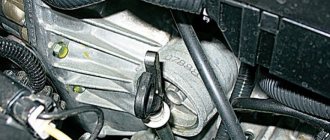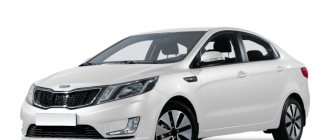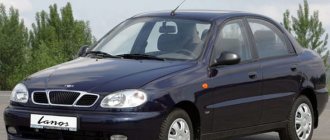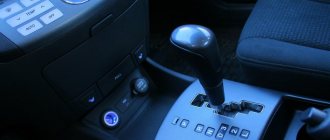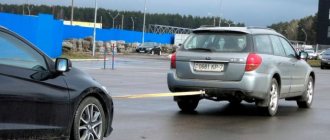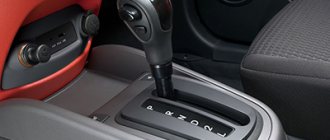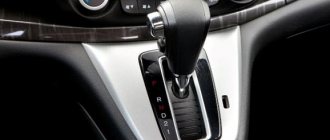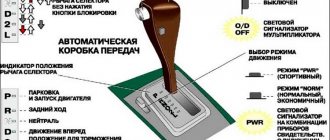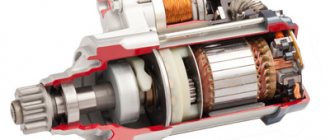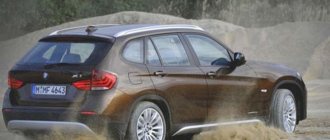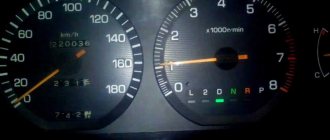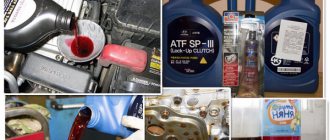23.09.2019
| (Votes: 2, Rating: 5) |
Issues discussed in the material:
- How does engine braking work?
- What are the pros and cons of such braking?
- How to brake with a manual engine
- Is engine braking possible on automatic and variator?
Reducing the speed of the car by pressing the brake pedal cannot always be considered the optimal solution. Experienced drivers use engine braking in some situations. However, to use this method, you must have certain skills. Incorrect actions can lead to accelerated wear of the motor and various breakdowns. In this article we will tell you in what situations it is worth using engine braking on cars with different designs.
How does an engine brake a car?
The design features of internal combustion engines are that for these units it is more natural to operate at idle. When the driver presses the accelerator, the engine speed increases, but as soon as he releases the pedal, the speed drops. If such actions are performed while the car is moving, then as the engine speed drops, the speed of the car also decreases. This process is called engine braking. The method of reducing the speed of a car without using braking systems is an important skill that allows you to prevent wheel locking during braking on a slippery road, as well as to avoid an emergency situation in the event of an unexpected breakdown of system elements.
How does engine braking help reduce vehicle speed? This method is based on the resistance of the power unit to inertial loads aimed at increasing the number of crankshaft revolutions. The process occurs at the moment when the car is driving at speed with the gear engaged, and the supply of the fuel mixture is reduced or stopped altogether.
A drop in the volume of fuel entering the internal combustion engine leads to a decrease in the amount of energy transferred by the engine to the transmission, which in turn begins to transfer the inertia of the rotating wheels to the engine. This leads to a drop in crankshaft speed and the car loses speed.
Let's consider the features of the engine braking process. First of all, it should be noted that in this case it is not always possible to provide a noticeable reduction in the speed of the car. When you press the accelerator, the supply of the fuel mixture increases, which leads to an increase in the number of crankshaft revolutions (the engine “spins up”). When you release the gas pedal, the speed decreases.
If we take a simplified look at the operation of the transmission, we can note that the function of the gearbox is to transmit and distribute torque to the wheels. In other words, the gearbox transfers a certain amount of motor energy, depending on the selected gear.
When driving in lower gears (1st to 3rd), maximum force is transmitted to the wheels, but the car will not be able to reach the highest speed. After engaging higher gears, the car can drive faster, but the acceleration energy will decrease, since the gearbox can no longer transmit maximum force from the engine, as in first gears.
In higher gears, the car accelerates much less, and in most situations the car can only maintain the achieved speed. In 4th, 5th and 6th gears, more significant inertial forces begin to operate, so engine and transmission resistance is minimized.
We recommend
“Why engine valves knock: top 5 reasons” Read more
Thus, good acceleration dynamics can only be ensured when driving in lower gears. It is at such moments that, by releasing the gas pedal, you can provide significant resistance to inertial movement. If you let off the gas in higher gears, the car’s deceleration will not be so noticeable, since the inertial resistance will be low.
How to brake correctly or how to think correctly?
So, the method of braking depends on the situation on the road. But I imagine that many drivers want to use ABS braking as little as possible and slow down smoothly and calmly as often as possible. And this means only one thing: you need to avoid situations in which emergency braking is required. Therefore, the question “how to brake correctly” comes down to the question “how to avoid unexpected obstacles on the road . After all, if the situation has already occurred, then we cannot adjust it to the desired method of braking. Here we can only choose the appropriate braking method and adapt to the situation. But you can adjust the situation on the road to suit you before it happens! How? By normal forecast. To do this you will need the following:
- look at the road as far as possible
- pay attention to the road, not to the text message you are typing while driving

- attention to both the road and surrounding areas, especially those that are hidden from view (parked cars, buildings, green spaces, etc.)
- safe distance to the car in front
- refusal to try to catch up or overtake traffic
As a result, you will only have to use the information received correctly and predict the possible consequences. The trick is that you will be able to recognize possible complications along the way much in advance , and the concepts of “unexpectedly” or “suddenly” will simply cease to exist for you. And then you will also start braking in advance, at a greater distance from the obstacle . This means that by correctly and timely analyzing the road situation, you can allow yourself, instead of lightning-quickly hitting the brake pedal, to just release the gas pedal .
It turns out that braking safely means thinking correctly .
Pros and cons of engine braking
The main benefit of engine braking is that the risk of the vehicle skidding is significantly reduced. When the driver presses the brake pedal, the wheels lock and, consequently, the car loses control. To minimize the risk of a car skidding, automakers equip modern models with active electronic safety systems, but on a slippery road, even ABS cannot guarantee the complete absence of a skid.
Taking into account the information presented above, we can come to the conclusion that engine braking can be considered an anti-accident technique on a slippery road. Drivers often use this method on long descents, mountain roads, and when driving along serpentine roads or during icy conditions. It prevents wheel locking and protects the system from overheating caused by too much braking.
Drivers often use engine braking in situations where it is possible to drive on the highway at full speed, to save fuel, as well as to reduce wear on brake pads and discs. In this regard, it is attractive that in modern injection models of cars with a manual transmission, the supply of the fuel mixture stops when the accelerator is released.
It is also worth remembering that engine braking can come to the rescue if the brake system is faulty. It’s worth considering here that you won’t be able to immediately stop the car using this method, especially when driving downhill, but you can slow down, which will allow you to use the standard braking system with minimal risk and without much damage.
We must recognize the validity of skeptical opinions that engine braking can harm the power unit. What are these judgments based on?
We will begin to consider the adverse consequences of reducing the speed of a car due to the engine with a rather simple and invisible problem caused by the asymmetry of modern internal combustion engines. To reduce the lateral load on the piston while it is at top dead center, the designers moved the piston pin relative to the cylinder axis. In this case, the axes of the crankshaft and cylinders do not coincide. When the engines are braking, the asymmetry begins to work against the internal combustion engine.
There is an increase in lateral loads on the piston (at the same torque value, such loads will be higher than for the working stroke). The asymmetrical design of the crankshaft bearings, connecting rods and piston pin is also designed to take into account the loads of the power stroke and does not take into account those that occur during engine braking.
It is worth noting that the lack of fuel supply leads to the fact that the internal combustion engine valves will operate “dry”, but even with prolonged engine braking, this factor slightly increases the wear of the valves (in addition, they cool down at such moments). For internal combustion engines that undergo a “cold run-in”, such a technique can be considered as forced idling, extended over a longer period. But it should be noted that the valve seats in this case will be subject to greater wear than during normal operation of the power unit.
The vacuum created in the intake manifold, which will be 1.5 - 2 times higher than at idle, can also harm the engine. Strong vacuum increases the load on the crankcase ventilation system and leads to leakage of various seals. In addition, outside air may be leaked.
The greatest troubles can occur when the valve seals are severely worn. Strong vacuum causes oil to flow into the intake manifold from the camshaft. In addition, oil will be drawn into the cylinders through the piston assembly. If the internal combustion engine is equipped with a turbine, then oil will also flow into it, which often causes failure of this unit.
An increased flow of oil into the intake manifold, which is especially typical for worn-out engines, contributes to the formation of carbon deposits on spark plugs and pistons, as well as to catalyst failure and increased harmful emissions through the exhaust system into the environment. Vacuum and pressure surges cannot but affect the condition of the flexible components of the inlet assembly (pipe, valve, etc.).
When the engine brakes, dirt and dust from the intake manifold will enter the cylinders. This factor can cause especially great harm if the catalyst is located close to the collector. In this mode, the working substance of the catalytic system will crumble. During operation under load conditions or when warming up engines with direct injection, there is a large amount of solid soot particles in the intake system. Such particles, along with dust, enter the engine cylinders, which is caused by the overlap of the valve timing (which is why the engine manages to draw in a small amount of air from the intake manifold. If the design of the exhaust system includes an EGR valve, then over time its tightness may deteriorate, which leads to the entry of dirt and dust into the intake manifold and, as mentioned earlier, into the cylinders.Solid particles of dust and dirt in the cylinders lead to scoring on their walls and damage to the valves.
We recommend
“How to properly turn off a car engine: some useful tips” Read more
During engine braking, a sharp change in the number of crankshaft revolutions occurs, which leads to shock loads on engine parts. This effect can be equated to the consequences of careless handling of the gearbox and clutch. But it should be noted that fluctuations in rotational speed in running engines occur constantly, and damper pulleys, idle clutches, etc. are used to protect the transmission.
The most significant disadvantages of the engine braking method include the increasing risks of creating an emergency situation. The car slows down, but the brake lights do not light up like when you press the brake pedal. As a result, the driver of the car driving behind may not react in a timely manner to the braking of your car, which will lead to a collision.
Mechanical engine braking
Reducing engine speed on a car with a manual transmission involves performing the following actions:
- Release the accelerator pedal.
- Depress the clutch pedal.
- When the car speed decreases, change to a lower gear.
- After the speed has been reduced as much as possible, engage 1st gear.
It is important to understand how to select a gear when braking with a manual engine. An error in this case can lead to motor damage. The fact that the gear has been selected incorrectly is indicated by too high speed readings on the tachometer and a sharp “nodding” of the car. This not only creates discomfort for the driver, but can also lead to damage to the internal combustion engine.
Incorrect engine braking modes, caused by untimely transition to lower gears, can lead to wheel locking, as a result of which the car may skid. In addition, violating the order of transition to low speeds increases wear on the motor and leads to the risk of damage to its parts.
When driving a car in 5th or 6th gear, you need to switch to 3rd gear to brake the engine, since 4th can provide a very slight reduction in speed. From 3rd or 4th gear you need to switch to 2nd. To make the switching process smoother, we recommend performing a “re-throttle”.
To completely stop the car, you need to use the car’s braking system after reducing the speed to 5-10 km/h.
How effective is engine braking? The answer to this question depends on several factors, the most important of which are experience driving a car, the ability to adequately assess the road situation, and the technical condition of the car.
Important
: using emergency engine braking techniques on a car that is equipped with an ABS system will lead to the loss of precious seconds, since this system copes with such situations much more effectively. But this rule also has its exceptions: if there is ice on the highway, then for safety reasons, to urgently reduce speed, you should choose the engine braking method.
There is an opinion that the engine braking system is more effective for cars equipped with diesel engines. This judgment is based on the fact that the compression ratio in diesel cylinders is almost 1.5 times increased. At the same time, there are no significant differences in the braking speed of gasoline and diesel engines.
When applying engine braking, you do not have to worry about increased fuel consumption. Fuel consumption will not exceed the values that are typical for stopping a car using the brake system. In both cases, the driver does not touch the gas pedal while reducing speed, so the level of fuel supply to the engine cylinders tends to zero. After gaining speed, fuel begins to flow in standard mode. Sometimes, for more economical fuel consumption, drivers use the coasting effect. If there is a long descent ahead of the car or the traffic light turns red, you can switch to neutral gear and roll so that the engine is idling.
We recommend
“Cleaning fuel system injectors: choosing products for gasoline and diesel” More details
When braking the engine, you need to monitor its speed. For gasoline power units, downshifting can be done at 2.5 thousand revolutions. The subsequent downshift is performed already at 1 thousand engine revolutions. It is not recommended to turn the steering wheel while braking, as this may result in loss of vehicle control.
Given the information provided here, we can conclude that it is important to acquire engine braking skills. This technique will be especially useful for owners of cars with a manual transmission.
What comes first: braking or shifting?
I’ll dwell in more detail on the question “what first: do we brake and then switch, or switch and then brake?” There are different opinions on this topic, and many racing drivers - professionals in their field - agree that you need to brake first and only then shift. In particular, Mikhail Gorbachev, whom I respect, writes about this in his books.
In my opinion, not everything is so simple, I will make some clarifications, after which everything will fall into place. Once again we will answer the question: why do we shift gears down when braking? In order to maintain the engine speed we need and not lose engine traction . Why is engine thrust needed when braking? Read more above, but here I will once again briefly describe the main points:
- for the possibility of intense acceleration to avoid a collision;
- for the possibility of engine braking to avoid loss of controllability;
- to create an anti-lock effect on the brakes. This is true for older cars without ABS, and I will not consider this issue here. Let me say briefly: if you have such a car, engage lower gears and you will brake even safer.
There is one more point - a sporting one:
- to enable intense acceleration out of corners and reduce time on the race track.
Brake at races
It is this last point that is most important for racing driving and is why racers always downshift when braking . At the same time, they switch not at medium speeds, as I recommend for city driving - at 2500 rpm, but at high speeds: so that after switching, the tachometer needle rises to the red zone. And the car in racing mode on the straight line goes in intense acceleration mode, the tachometer needle is in the speed range and by the end of the straight line it often reaches the red zone. It is clear that in this situation the driver cannot and should not shift before braking, since in this case the tachometer needle will go off scale. First he brakes, the revs drop from the maximum, say, from 7000 to 5000, after which he shifts down the gear, raising the revs again to the maximum - 7000 rpm in our example.
Is engine braking possible on automatic?
In the previous section, we figured out that in order to reduce the speed due to the engine in a car with a manual transmission, you need to consistently shift to a lower gear. Now let's look at whether engine braking is possible with an automatic transmission?
Automatic transmissions have a more complex design and shorter service life compared to manual transmissions. The machines consist of planetary and friction mechanisms, an oil pump and other elements. In this case, interaction with the engine is ensured by the torque converter. On a car with an automatic transmission, you can also use engine braking, but it is less effective compared to a manual transmission.
The shape of the torque converter resembles a lifebuoy, inside which two turbines are installed, placed in an oil reservoir. There is no direct mechanical connection between the turbines, but when one of them rotates, the blades begin to direct oil flows in a circle and set the other in motion. This is how torque is transmitted.
When the car picks up speed, the hydraulic coupling is blocked, the shafts begin to rotate synchronously, and torque is transmitted directly. When engine braking occurs, the fluid coupling lock is disabled at a speed of about 50-60 km/h. At this moment, the oil damper begins to work, smoothing out the loads. The hydraulic coupling effectively compensates even for high loads on the automatic transmission, protecting the transmission from damage. The torque converter allows different rotations of the input and output shafts without damaging the entire mechanism. At the same time, load smoothing has a negative impact on the efficiency of speed reduction, so a car with an automatic engine brakes much slower than a car with a manual transmission.
Buyers of cars with an automatic transmission need to carefully study the operating instructions, paying special attention to the operating modes of the transmission. For some types of automatic transmissions, designers do not provide engine braking at all, and in other automatic transmission models this mode is blocked by the electronic control system. There are modifications of automatic transmissions in which the engine braking mode begins to operate without driver intervention. In some automatic transmission models, a manual gear shift function is provided to reduce the speed of the car due to the motor.
As an example, consider one of the possible options for engine braking on a car with an automatic transmission:
- You need to enable overdrive mode, after which the automatic transmission will switch to 3rd speed.
- When the driving speed decreases, you should set the 2nd gear, which will facilitate the braking process.
- The automatic transmission lever must be placed in the “L” position, which corresponds to 1st gear.
While the car is moving, the automatic transmission lever can only be set to the “D-2-L” positions; turning on other speeds can lead to damage to the gearbox (it is strictly forbidden to use the “R” and “P” positions while driving).
In most cases, electronic systems themselves control the operation of the automatic transmission. So, at high speed, the electronics will not allow you to force a switch to 1st gear.
The technology of engine braking in a car with a hydromechanical automatic transmission is reminiscent of driving a manual transmission with the clutch not completely disengaged (the gear is engaged, the engine hums, but the speed is not reduced as effectively). The car, moving downhill, rolls faster and faster, so the driver has to regulate its speed with the brake pedal.
Based on the information above, we can conclude that cars equipped with automatic transmissions can brake with a motor and have electronic systems that protect against breakdowns. In addition, the loads transmitted from the wheels to the automatic transmission are damped by a fluid coupling, and therefore it is impossible to damage the transmission when driving downhill. At the same time, an automatic transmission cannot provide effective engine braking, so you should not be particularly careful with the brake discs and pads.
We recommend
“Diagnostics of a car engine: review of means and methods” More details
If the instructions for a car with an automatic transmission indicate that this modification does not have an engine braking mode, then such a technique should be used only if absolutely necessary, so as not to shorten the service life of an expensive Automatic transmission.
To summarize, we note that engine braking is more effective for a car with a manual transmission, since in this case a rigid clutch of the transmission gears is ensured. When driving a car with an automatic transmission, you should rely more on the braking system.
The safest braking is smooth
Of course, on a slippery road, and not only on a slippery one, it is safer to brake as long as possible, that is, as smoothly as possible. And since the engine always slows down the car more smoothly and “longer” than the brakes, engine braking is the safest. But precisely because of the different braking distance lengths, and not because of anything else. So you can't just replace one brake with another. To use engine braking, you must first adopt a driving style that allows you to do without the brake pedal. Well, or not completely do without brakes, but at least use them less often and with less intensity. And the key to this is early braking!
Engine braking with CVT
It is not at all difficult to reduce the engine speed in a car with a CVT. Many modifications of transmissions of this type have a corresponding function (the lever is set to the “L” position). The variator itself reduces the speed of the car, setting a suitable gear after the driver releases the accelerator if the lever is set to position “D”. With such driver actions, so-called dynamic engine braking automatically occurs.
To improve the dynamics of cars with a variable transmission and reduce fuel consumption, many owners of such cars want to disable the engine braking option in software. Experts do not recommend rushing to such a decision. Reducing the speed of movement due to the motor is a quite useful function. Every driver should master this technique, even if he is not a fan of extreme driving. Additional emergency driving skills help you avoid accidents in difficult driving situations.
When to use the engine braking method
The opinion that engine braking can harm a car has a right to exist (especially in the case of cars with more than 150,000 km on the speedometer). Nevertheless, from a safety point of view, mastering this technique will be useful for every driver. Here are a few recommendations that will help you use the engine braking technique in a gentle mode for the power unit.
1. You should not reduce the speed of the car too much using the engine . Apply engine braking in higher gears and try not to engage in lower gears unless absolutely necessary. In city traffic, brake in 4th or 5th gear until the engine speed drops to idle speed. On mountain roads, you should initially select a low gear (so that the engine pulls the car on climbs and reduces speed on descents without unnecessary shifts). Even if the car has an ABS system, on a slippery road at a speed of less than 30 km/h, the process can be safely completed by braking in neutral gear.
2. In city traffic, it is not recommended to use prolonged engine braking . In urban conditions, you should choose a speed limit that will require a minimum amount of braking. Using the motor to reduce speed will not save you from the consequences of mistakes when choosing a speed mode. In this case, about 70% of the vehicle's kinetic energy is wasted. Driving in city mode in low gears, adjusting the speed only with the accelerator pedal, without using the brakes, is harmful to the engine. This technique for driving a car can only be justified if there is a malfunction of the brake system, transmission or clutch.
In what cases should you use engine braking?
- If the car's brakes have completely or partially failed.
- When there is a long descent ahead.
- When driving on mountain roads and serpentines.
- If the road is wet or slippery, engine braking will provide more traction on the road surface.
In icy conditions, you should use the clutch carefully, as if you drop it suddenly, the drive wheels may lock. When performing engine braking, it is also important to pay attention to the length of the braking distance and the rapidity of the reduction in speed.
Torque and safety
Hence the conclusion: when reducing speed, engage lower gears, and then you will increase the safety of your movement. Engage a lower gear every time the tachometer needle drops to 2500 rpm on a naturally aspirated gasoline engine, up to 2000 on a turbocharged gasoline engine, and up to 1500 on a diesel engine. It is possible at higher speeds, this is at your discretion. But definitely not at lower ones; here I give the lower averaged limits. I recommend that you check the maximum torque values for your car and base it on this when changing gears.
It is especially important to engage a lower gear when cornering, since the car on an arc is much less stable than on a straight line. Details and practice in the courses “The Magic of Shifting”, “Driving on a Race Track” and “MBA Driver Course: Mastery of Car Driving”.
By the way, pay attention to the tachometer of your car. It is numbered to approximately 7000 rpm if you have a gasoline engine, and up to 5 thousand if you have a diesel engine. Think about it, why are such high speeds provided in the car? And here’s the question: why, if the average driver keeps the speed in the region of 1500-2000? If you are one of these drivers, this is a good reason to think about the correct driving style...
Which braking method is best to use?
What is the best way to stop a car - using engine braking or the brake system? In normal day-to-day operation of the machine, both methods should be combined. Braking using only the standard system is in many cases dangerous and is considered illiterate from the point of view of the quality of driving. The combined braking method involves reducing speed by pressing the brake pedal without changing gear. This method is the most effective and safe.
The use of engine speed reduction techniques and ABS braking provide different deceleration rates and therefore lead to different results.
An emergency reduction in speed with ABS occurs at the limit of permissible adhesion of the tires to the road surface. This braking mode allows you to stop the car as quickly as possible and reduce the braking distance.
It is quite difficult to carry out sharp engine braking, so with this method the braking distance will be maximum. We will not consider the case of a car stopping due to a drop in inertia forces in neutral gear (car coasting).
Thus, the question “how to brake - with the engine or using the braking system” takes on the following formulation: “what is the best way to stop the car - sharply or smoothly?”
It is impossible to give a definite answer. For example, let's take a situation when a car is moving along a city road, and ahead at a distance of about 0.5 km the traffic light turns red, so the driver decides to slow down. If you press the brakes so that the ABS is activated, the car will stop quickly, but not in the place where it is necessary. When driving at a speed of 60 km/h on a snowy road, the braking distance of a car with winter tires will be approximately 70 meters.
In the example described here, it would be more rational to use the engine braking technique. The driver can simply release the gas, and the car will begin to gradually lose speed as the engine speed decreases. Thus, the car will approach the traffic light at a minimum speed, and at the right place it can be stopped by lightly pressing the brake pedal. If the inertia of the car is not enough to reach the traffic light, then the driver can gradually press the accelerator, and, conversely, if the distance is not enough to stop, you can smoothly press the brake, slightly increasing the braking.
We recommend
“Repairing a Volkswagen Touareg diesel engine: weak points and types of repairs” Read more
Now let’s take a different situation. For example, a pedestrian suddenly runs out onto the road, or when approaching a closed turn at normal speed, the driver sees a car with the hazard lights on. In such cases, you need to understand that engine braking will not allow you to avoid a collision; the only way out is to sharply press the brake. And to the accompaniment of the crackling ABS, hope that the remaining space will be enough to stop.
As we can see, different braking options are used for different driving situations:
- If there is enough room to stop, the engine braking technique should be used;
- if the intensity of engine braking is insufficient, this technique should be combined with the stopping method using the standard braking system;
- if you doubt that the car will have enough space to stop, you should use combined braking from the very beginning (press the brake pedal while the gear is engaged);
- if there is critically little space to stop, you need to brake sharply using ABS (press the clutch and brake all the way).
Stopping a car with ABS allows you to disengage the clutch, since during sharp braking the engine will no longer affect the intensity of the speed reduction, but when the gear is engaged, it may stall. This is why car manufacturers and driving instructors recommend depressing the clutch when braking in an emergency.
What happens when an engine stops:
Making the Word Map better together
Hello! My name is Lampobot, I am a computer program that helps you make Word Maps. I can count perfectly, but I still don’t understand very well how your world works. Help me figure it out!
Thank you!
I began to understand the world of emotions a little better.
Question: see you
- is it something neutral, positive or negative?
Associations to the word “stop”
Associations to the word “engine”
Synonyms for "stop"
Synonyms for the word "engine"
Sentences containing the phrase “engine stop”
- The ignition switch is a device necessary to start and stop the
vehicle engine, as well as to turn the ignition on and off.
The meaning of the word "stop"
STOP, -i, gen. pl.
—vok,
dat.
—vkam,
w.
1.
Action according to verb.
stop (in 1 digit)
and
stop (in 1 digit).
Stopping a train with a brake.
(Small Academic Dictionary, MAS)
Meaning of the word "engine"
ENGINE, -i, m.
1. A machine that turns smb.
type of energy into mechanical energy. Steam engine.
Internal combustion engine. Jet engine. Engine of excavator mechanisms. Drilling rig engine. (Small Academic Dictionary, MAS)
Aphorisms of Russian writers with the word “stop”
- Beyond the momentary stop of blurred consciousness lies another world. We are at the weakest point in life. The one through which death is felt.
Submit Comment
Additionally
- How to spell the word "stop"
- How to spell "engine" correctly
- Analysis of the composition of the word “stop” (morphemic analysis)
- Analysis of the composition of the word “engine” (morphemic analysis)
The meaning of the word "stop"
STOP, -i, gen. pl.
—vok,
dat.
—vkam,
w.
1.
Action according to verb.
stop (in 1 digit)
and
stop (in 1 digit).
Stopping a train with a brake.
Meaning of the word "engine"
ENGINE, -i, m.
1. A machine that turns smb.
type of energy into mechanical energy. Steam engine. Internal combustion engine. Jet engine. Engine of excavator mechanisms. Drilling rig engine.
Sentences containing the phrase “engine stop”
Ignition switch - a device necessary to start and stop the engine
vehicle, as well as to turn the ignition on and off.
Is it worth braking with the engine: the opinion of car enthusiasts
- “Continuous use of the brakes is harmful because kinetic energy is converted into heat, which further reduces the efficiency of the motor. It’s better to drive in a quiet mode, smoothly picking up and reducing speed without using the brake pedal, but only using the engine by switching to a lower speed.”
- “How often do you need to brake using the engine to ensure noticeable fuel savings? If, when reducing speed using the braking system, the fuel consumption is about 1.5 liters, then to save this amount of liters you need to brake for a total of 100 km. Does it make sense to force the engine like that?”
- “Engine braking is a dangerous technique. With this method of reducing speed, the “stops” do not light up, so the driver driving behind may not have time to react to this maneuver in a timely manner. My car’s rear bumper was dented.”
- “Pressing the brake pedal on a long descent will lead to overheating of the discs and pads. For me, the question of the dangers of engine braking is not relevant. If you turn on the reduced speed in a timely manner, then this speed reduction option will not affect the motor in any way. It seems to me that the load on the motor when accelerating or braking is the same. If there is any difference, let the experts explain it to me. I find engine braking helpful when going downhill, downhill, etc.
We recommend
“How to drain the coolant correctly and fill it with new one” Read more
- “Experienced drivers (maybe immodestly, but I consider myself like that) use engine braking without thinking about the harm or benefit of such a technique. There's no harm in it. Motors, transmissions, and injectors and ECUs are designed to operate in this mode, not only in emergency situations. The injector cuts off the fuel supply to increase braking efficiency and reduce fuel consumption. When the speed drops to idle, the injectors start working again. The same principle was used in the operation of EPHH on carburetor engines. This type of braking saves fuel and also extends the life of brake pads and discs. Moreover, the process of reducing speed is often safer (especially on ice). The risk of transmission failure is present only if the box has already exhausted its service life.”
- “Once, while braking with the engine, I accidentally switched into 1st gear right after 3rd, and the car went into a skid, almost flying into the oncoming lane. After that, I use this technique extremely carefully.”
- “During sudden braking, unusual situations often arise. The car is capable of changing its trajectory; a car running parallel can skid or approach sharply. Using the engine braking technique, you can quickly correct the situation by pressing the gas pedal.”
- “Engine braking can and should be used. In some not very serious films there are moments when the “hero”, whose brakes have been broken by attackers, tries in vain to stop the car, nervously pressing the brake, and crashes. Even a not very experienced driver in such a situation would have long ago remembered that the engine can also reduce the speed. This technique can even be applied to cars with automatic transmission.”
Let's sum it up
It is quite obvious that mastering this braking technique will be the right decision for every driver, especially if the car is manual. You should always take into account:
- Only proper execution means that you will not cause harm to the gearbox and motor. Do not abuse this method or sharply brake the engine unnecessarily.
- This braking method can create an emergency situation on the road for vehicles moving behind you; if done incorrectly, it will reduce the service life of the engine and transmission, and can also lead to serious damage.
- As for saving fuel, the benefit from this method of braking turns out to be extremely insignificant.
- If the car has an automatic transmission, then it is necessary to study separately and with increased attention the issue regarding the feasibility and general feasibility of engine braking on a specific car model.
